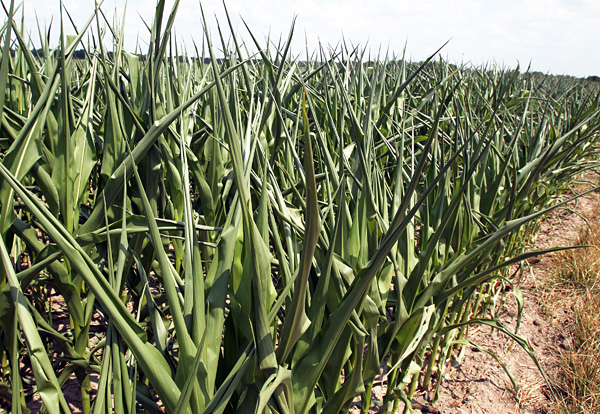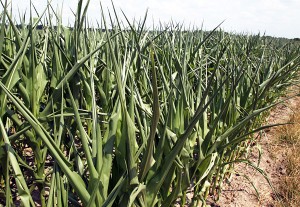Severe to extreme drought conditions in Iowa will take a significant toll on corn yields, but there is still hope for a productive soybean crops if timely rains occur during the remainder of the growing season, top state officials said Monday.
Gov. Terry Branstad said about 75 percent of Iowa fields are in severe drought stages, while 25 percent of the crop acres are in extreme drought stage, given that July’s rainfall has been about a third of what the state normally receives.
Iowa Agriculture Secretary Bill Northey said crop conditions vary across the state, but he noted no area “has been spared” as pasture lands dry up and some farmers already are chopping stunted corn stalks for livestock silage. Currently, Northey said, the state’s corn crop is at its “maximum potential” and likely will see stunted growth and maturity if the current spate of extremely hot and dry weather persists.
“We certainly will see a significant reduction from the past. Pretty much every area of the state will see a reduction from what they had last year and what they would expect normally, but we don’t yet know how much of a reduction. It depends on how much more rain comes,” Northey said in assessing the state’s corn production this year.
“It’s not going to get any better, but it could get worse,” added Branstad, who provided a status report on Iowa’s 2012 crop situation during his weekly news conference. The governor said there is still hope for soybean fields in Iowa because they have been in “a holding pattern” this month and could fare better than corn production if timely rains occur in August.
Northey said agriculture has been a major economic engine in Iowa for the past five years and it’s unknown what impact this summer’s drought will have financially given that the quality of grain, yields and livestock production already have been adversely affected by the prolonged hot and dry conditions.
“I do believe harvest will come early,” the ag secretary said, noting that some combining could get under way in August in areas hardest hit by the drought.
Mark Schouten, director of the state Department of Homeland Security and Emergency Management Director, said rural water systems in Iowa currently are in good shape to meet demand but state officials are closely monitoring conditions to take proactive measures should the situation worsen.
“We want to assure Iowans that every effort will be taken on their behalf with regard to this drought,” Branstad said. “We will work with federal partners, state agencies and departments, and all Iowans as we combat the effects of this drought. This is a top priority of my administration.”
Branstad said the most recent federal USDA drought monitor shows that almost 75 percent of Iowa is now in the D-2 severe drought stage and roughly 25 percent in the D-3 extreme drought stage. At the time of the governor and lieutenant governor’s drought summit in Mount Pleasant less than two weeks ago, just 12 percent of Iowa’s land was considered in a D-2 severe drought stage, he noted.
Two weeks ago, the governor sent a letter to U.S. Agriculture Secretary Tom Vilsack informing him of the worsening conditions in Iowa, where he requested the secretary to declare secretarial disaster designations for Iowa counties as soon as they qualify. Recently, Vilsack announced the USDA will open CRP lands for emergency grazing in 26 counties in Iowa and that CRP lands will be open for the rest of Iowa counties as soon as Aug. 2 for haying and grazing.
Last week, state-owned land managed by the state Department of Natural Resources was opened for our farmers and producers for emergency grazing and haying. Having access to additional 6,000 acres is something that should provide immediate relief to those who are being impacted by these conditions, Branstad said.
The governor also approved a proclamation that temporarily waives certain weight and width and hours of service requirements for those transporting hay, straw and stover, and the state opened up DOT roadside ditches as another avenue for our farmers to bail hay. Under the program, farmers can obtain a DOT permit to bail roadside ditches as an economical and efficient way for producers to obtain hay for their livestock.








